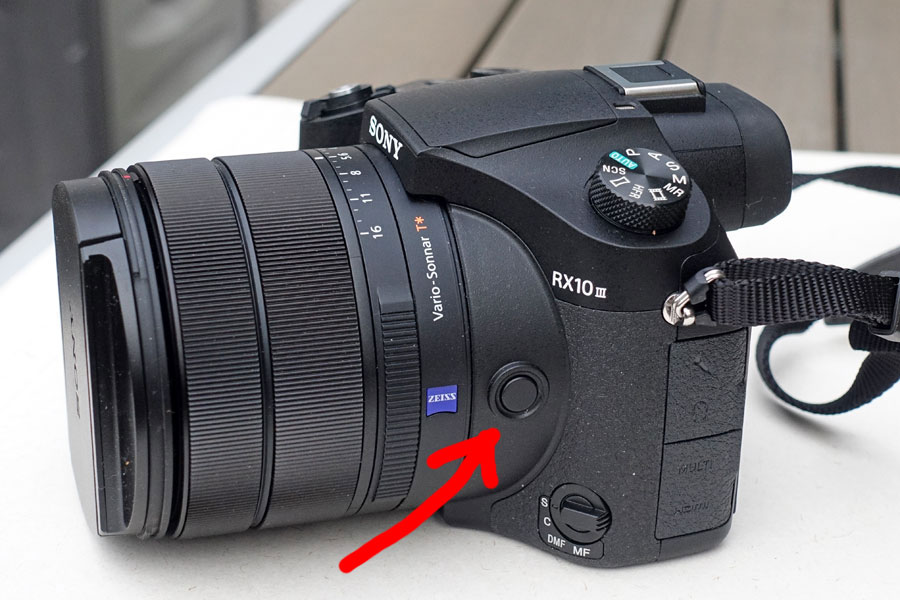Sony RX10 M3: Manual Focusing and Focusing Support
How Is Manual Focusing Supported on the Sony RX10 M3/4? - Overview | Sony RX10 M3/4 Manual Focus Methods | Locking Focus | Setting Fixed Distances | Support for Manual Focusing | Conclusions | References | Appendix: Discussion of Setting the Focus to Infinity
On this page, I describe how manual focusing works with the Sony RX10 M3/4 camera and how it is supported.
Note: For an overview of manual focusing methods, see page Manual Focusing Methods.
How Is Manual Focusing Supported on the Sony RX10 M3/4? - Overview
Depending on the needs of the photographer, the Sony RX10 M3/4 offers several methods of focusing manually:
- Manual Focus (MF): The user sets the focus manually by turning the focus ring (one of the two lens rings).
- Direct Manual Focus (DMF): The user manually overrides the distance set by autofocus (or vice versa)
The Sony RX10 M3/4 allows you to lock focus, albeit there is no direct function for this, and also, with some "trickery," to store fixed distances for later use:
- Focus Lock: Locking the focus at a certain distance for one or more shots by switching from AF to MF using the Focus Mode, Focus Hold, or the AF/MF Control Toggle functions
- Storing Fixed Distances: Fixed distances can be stored for later use (as a kind of "snap focus distance" or for use as "hyperfocal distance") using memory locations
Manual focusing is furthermore supported in several ways (but note that these methods can also be used for autofocus):
- Focus Peaking: Contours that are in focus are highlighted in various ways
- Magnification comes in two flavors: Manual Focus Assist and Focus Magnifier
Sony RX10 M3/4 Manual Focus Methods
Manual Focus (MF)
To focus manually, first set Focus Mode to MF using the Focus Mode dial (there does not seem to be another way to do this...).
Focusing manually is done using the focus ring at the lens. There are two rings at the lens, and you can decide whether you want to use the front lens ring (default) or the rear lens ring.
On the Sony RX100 M1, I never know, which direction to turn the focus ring (which is the coontrol ring) and where I am on the distance scale. Except for the sharpness of the screen, this camera does not provide any information on the set distance. This is really a shame for such an otherwise well-made camera. The RX100 M4 is better here and displays a coarse distance scale, which helps a lot because I still cannot remember, in which direction to turn the control ring (you have to turn it left for moving towards infinity...). The distance scale appears as soon as you turn the control ring and disappears 2 or 3 seconds after you stopped turning the ring. The RX10 M3/4 tops this by offering you the choice in which direction you want to turn the focus ring. So you can select a direction that feels "natural" to you can can be remembered. I set it so that turning the ring right moves towards infinity.
Some people say that turning the control ring or a lens ring for focusing is intuitive and provides a focusing experience similar to an camera with manual focus. Others, however, say that the experience is rather "indirect", since focusing is "by wire," and turning the wheel is rather tedious because there are no stops at the end (which a manual lens provides). All in all, I have to agree with the latter. Sony should have taken a look at the Leica X Vario, which does manual focusing so well that is "feels" manual, even though it is "by wire."
On the Sony RX10 M3/4, manual focusing feels sluggish for me, and it has a hysteresis, that is, if you change direction, you have to turn the focus ring quite a while before focusing resumes. This is quite nerve-straining. I also observed that if I move the focus ring to and fro to find the optimal focus, the optimal focus point moves to different positions of the ring. So when you keep the hand on the ring all the time, the position of your hand changes over time for the optimum focus point, which may become quite awkward...
One more problem with manual focus on the RX10 M3/4 is that at long focal lengths you cannot find the "infinity position" for the ring when there are no objects at infinity that you can focus on. With a mechanical manual focus, you simply turn the ring to the infinity position (or sometime to a different position). But here, the optimal position seems to be "somewhere" before the "infinity marker" on the distance scale (see a discussion on this topic in the appendix below). Simply turning the focus ring to the "infinity marker" on the distance scale therefore definitely delivers fuzzy results. Thus, it is nearly impossible to focus on stars at night, whereas it is possible to focus on the moon because there is something to focus on in the EVF or on the LCD screen. I found a somewhat similar behavior for the Sony RX100 M4, but to a lesser degree, and on the Panasonic TZ202, but there it is somewhat more consistent.
Another problem that I have with focusing manually on the RX100 M1 is that, being used to an EVF, I find it hard to recognize on the LCD screen when an object is in focus - even focus peaking and magnification do not help me much, particularly in bright light. The RX100 M4, on the other hand, offers an EVF, and my first impression is that it does help, but that a lot of fiddling is required because of the sluggish behavior of the control ring. The EVF of the RX10 M3/4 has a larger magnification so that you can see the pixels, but the larger size of the image itself seems to make focusing easier for me (there is still the sluggish behavior of the focus ring, though).
Direct Manual Focus (DMF)
Direct Manual Focus (DMF) allows you to override autofocus manually (and vice versa). To use direct manual focus, first set focus mode to DMF using the Focus Mode dial (there does not seem to be antoher way to do this...).
Note that DMF works in two directions: You can (1) either focus automatically and then override the focus manually by turning the control ring at the lens, or you can (2) focus manually first and then fine-tune focusing using autofocus. Also note that when using DMF, manual focus support is available (for details see below), provided that you activated it in the menu. Here are the detailed procedures for using the two approaches:
- To use DMF the first way, you have to half-press the shutter
button to focus automatically. Then turn the focus ring to adjust
the focus manually while
still pressing the shutter
button half-way.
If you activated Manual Focus Assist, the screen will be magnified for 2 s, 5 s, or as long as you half-press the shutter button.
You can also change magnification if you assigned the Focus Magnifier function to a function button and press it briefly. This function will be active all the time, not only while half-pressing the shutter button.
If you activated Focus Peaking, it will also be active all the time, not only while half-pressing the shutter button. - To use DMF the second way, first turn the focus
ring to adjust the focus manually, then half-press the shutter button to
focus automatically.
Note that in this case, Manual Focus Assist does not work, but you can still use the Focus Magnifier function provided that you activated it.
If you activated Focus Peaking, it will also be active all the time, not only while half-pressing the shutter button.
Note: I never used DMF this way round...
I have some issues with the DMF functionality. First, I find it hard to turn the focus ring while half-pressing the shutter button. Often I release the shutter button or press it inadvertently, which is annoying. Second, since I usually turn focus peaking on, this in on all the time when I use DMF, not only when I half press the shutter button to adjust the focus manually. This disturbs the impression of the image for me (particularly if focus peaking is a bit strong).
So I looked for an alternative and found one. See below!
Locking Focus
Focus Lock
Locking the focus at a certain distance for one or more shots is useful in a number of occasions, such as sports photos where AF is too slow, series of photos, etc. (one might debate whether this is a manual focus method, but it fits in here...). The Sony RX10 M3/4 provides the following options for locking focus:
- Pressing the shutter-release button down halfway. Note that this also locks exposure! Mostly, I use this technique for the latter reason, not because I want to lock the focus.
- Pressing the Focus Hold Button (when set to its default function Focus Hold) to stop AF from working. Note that you have to press the button all the time, since the is no toggle version of this function, which I find a serious omission by Sony.
- Switching from autofocus to manual focus (AF/MF Control Toggle). This may sound cumbersome, but can be easily done if you assign the AF/MF Control Toggle to a button such as the Focus Hold Button (default: Focus Hold), a button on the control wheel* (default: Not set), or any other custom button.
*) Alexander White writes that this is not possible - on my camera it is!
While the technique of pressing the shutter-release button down halfway is easy to use, the coupling of exposure and focus lock can lead to problems. For example, when I take a picture of a landscape, and the image looks too dark, I point the camera lower to brighten the image up - but now the focus may be too close. The other way round, when I point the camera to the sky to darken the image, focus may not find a target.
Figure: The Focus Hold button
Pressing the Focus Hold Button all the time is cumbersome for me. I do not understand why Sony did not provide an additional toggle function for this purpose.
The AF/MF Control Toggle function* is an alternative to the Focus Hold function. It can be assigned to the Focus Hold Button, as I do, or to any other custom or control wheel button. It activates a "manual focus mode," which has the advantage or feature that the manual focus is set to the same distance as AF set it before (similarly to DMF). Thus, for pre-focusing you can first use the AF to set the appropriate distance and then switch to manual focus using the AF/MF Control Toggle function. Of course, this works only in cases where AF finds focus (for example, it may not work for sky or macro photos). You can use this technique either to quickly focus on nearby objects such as playing children or sports people, or to focus on distant objects such as the sky. In the latter case, this can replace the missing "infinity" setting (or is a workaround for it...) - at least for shorter focal lengths.
Thirdly, you can use this technique as an alternative to the DMF functionality without the hassles of having to press buttons all the time and to be disturbed by focus peaking all the time. The only thing that you have to observe is that, after having taken the shot, you have to toggle back to AF.
*) Alternatively, you can also use the Focus Mode dial for this purpose. See below for the difference between these functionalities.
Locking the focus as described here is not appropriate for setting the focus at a known distance (infinity is an exception; you may, of course, focus objects for which you know the distance) and particularly, for storing it for later use. This topic is discussed below.
Note: Since locking exposure and/or focus is interwined, I dedicated an extra page to the topic of "locking": Locking Focus and Exposure. Please read this page for details!
Addendum: The Interplay of the AF/MF Control Toggle and the Focus Mode Functions
The Focus Mode Dial allows you to select between several manual and automatic focus modes: MF, DMF, AFS-S, AF-C. This is the "primary" method to select the focus mode.
The AF/MF Control Toggle function switches between AF and MF, that is, in both directions, and might be regarded as a simplified version of the Focus Mode function. It can be assigned to any customizable or control wheel button*. In fact, it allows fast and easy switching between manual and automatic focus, but it is only meant for temporary use and sets the camera into a "specific mode." If you assign this function to a button that can be easily accessed, this is more convenient that fiddling around with the Focus Mode Dial. I use the Focus Hold Button which seems to be similarly fiddly for me - I will have to get used to this...
*) Alexander White writes that it is not possible to assign the AF/MF Control Toggle function to a control wheel button - on my camera it is!
Setting Fixed Distances
Initially, this section was called "Setting and Storing Fixed Distances". A reader pointed me the fact that storing fixed distances in memory locations is not possible (and I replicated his finding). So I removed the respective passage on storing fixed distances. After all that time since I created this page, I can no longer remember whether I indeed tested this feature or whether it was just my "wishful thinking"...
Setting A Fixed Distance
Regrettably, the Sony RX10 M3/4 displays only a rather coarse distance scale when in manual focus mode (see Figures below):
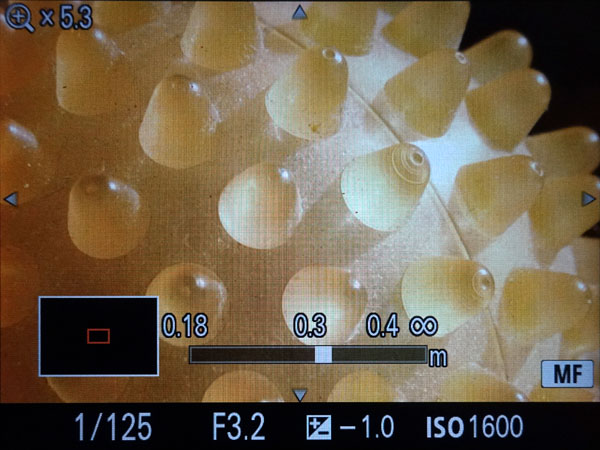 |
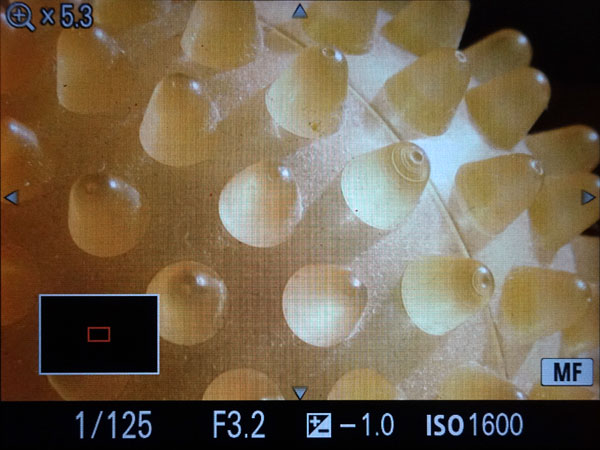 |
Figures: After turning the control ring, briefly, a coarse distance scale appears (left) - and disappears again after two to three seconds (right). In addition, an MF appears as well as an indicator of the magnification. The latter appear only if Manual Focus Assist is On.
Therefore, the question arises how you can set a fixed distance of, for example, 2 m on this camera. The only way to achieve this, is to select a target at a known distance (you may have measured the distance to the target using a measuring tape or using other aids) and then
- (1) Measure the distance using AF, and the switch from AF to MF either
using the
- AF/MF Control Toggle function*, or the
- Focus Mode function*, or the
- Focus Hold function, or
- (2) Measure the distance using MF, potentially assisted by the Focus Peaking and/or Focus Magnifier/Manual Focus Assist functions
*) All the functions set the camera to the same (fixed) distance as AF did. You may ask yourself whether using the Focus Mode, Focus Hold, or the AF/MF Control Toggle functions makes any difference. In practice, it does. For details, see here.
Support for Manual Focusing
The Sony RX10 M3/4 offers two tools that are meant to make manual focusing easier:
- Focus Peaking: Contours that are in focus are highlighted
- in three intensities (high, medium, low) and
- in three different colors (red, yellow, white).
- Magnification comes in two flavors:
- Manual Focus Assist: Magnifies an image section full screen for a predefined or unlimited time
- Focus Magnifier: Magnifies the center section of the image full screen after you press a dedicated control button
In the following, I explain these tools in more detail.
Focus Peaking
Focus Peaking is an approach to highlight contours that are in focus. On the Sony RX10 M3/4, contours are highlighted
- in three different intensities (Peaking Level: High, Mid, Low); "Off" cancels Focus Peaking
- in three different colors (Peaking Color: Red, Yellow, White); inactive when Peaking Level is set to "Off"
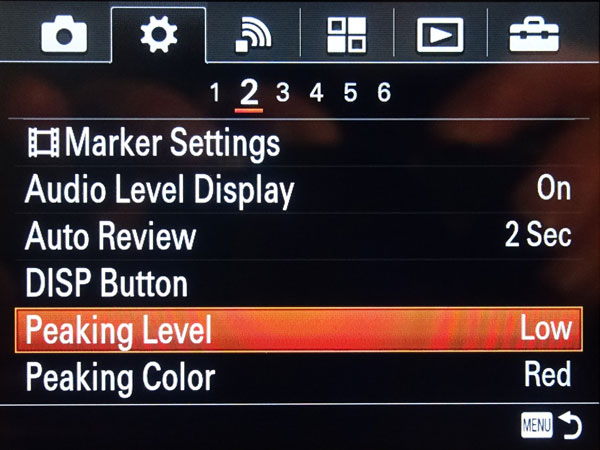 |
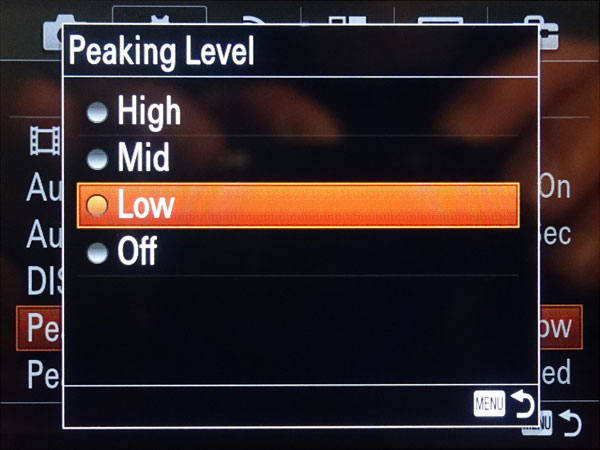 |
|
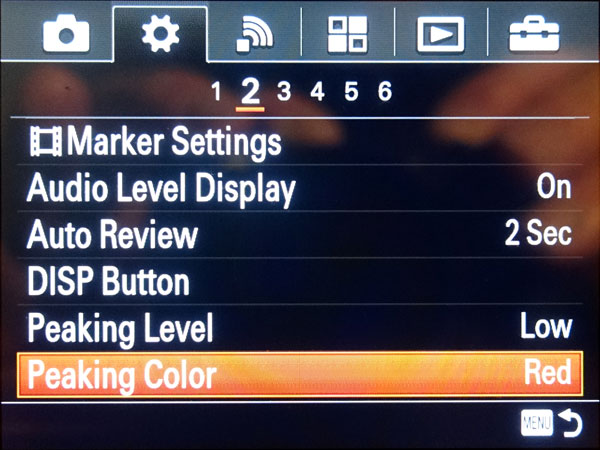 |
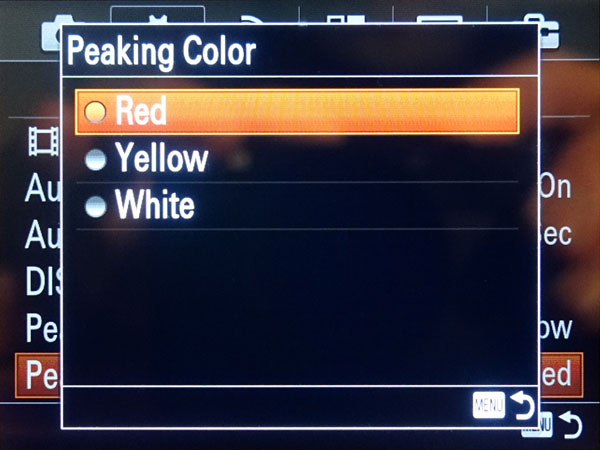 |
Figures: Setting Peaking Level (top row) and Peaking Color (bottom row) in the Custom menu (page 2)
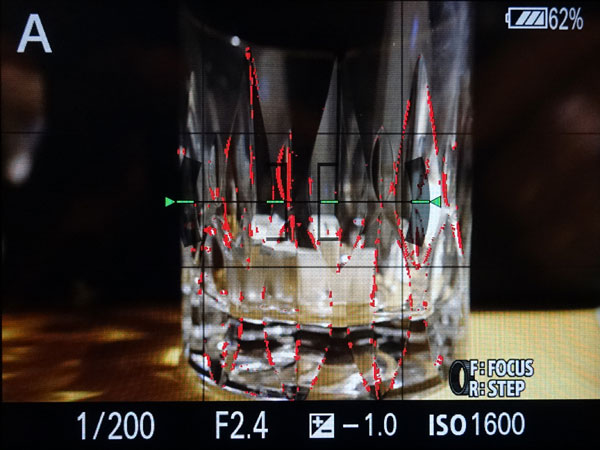 |
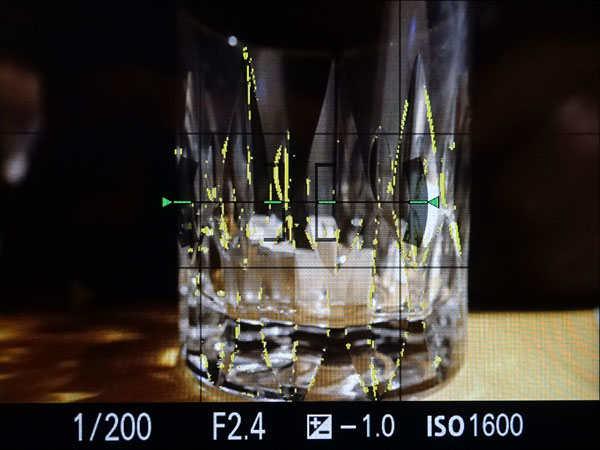 |
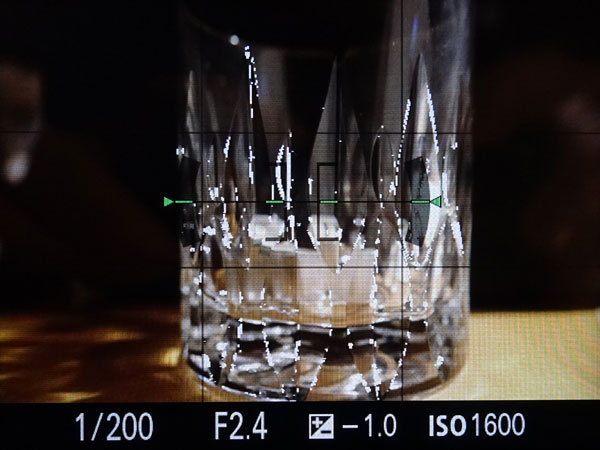 |
Figures: Peaking Colors red, yellow, and white (from left to right; Peaking Level: High)
Magnification
Magnification comes in two flavors: Manual Focus Assist and Focus Magnifier. Both show an enlarged portion of the image fullscreen.
Manual Focus Assist
Manual Focus Assist (or MF Assist) magnifies an image section full screen for a predefined (2 s, 5 s) or unlimited time as soon as you turn the control ring at the lens to focus manually, starting at a magnification of 5.3 x. If you press the center button, magnification increases to 10.7 x, pressing it again returns magnification to 5.3 x, and so on (see the Figures below). Half-pressing the shutter button (or if you take a photo...), cancels magnification, and you have use the to control ring again to re-activate magnification.
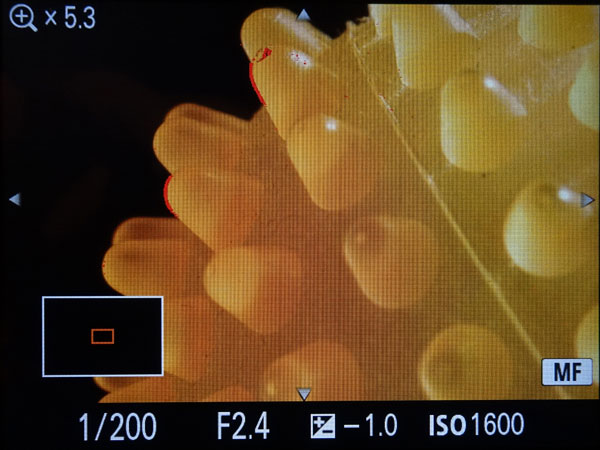 |
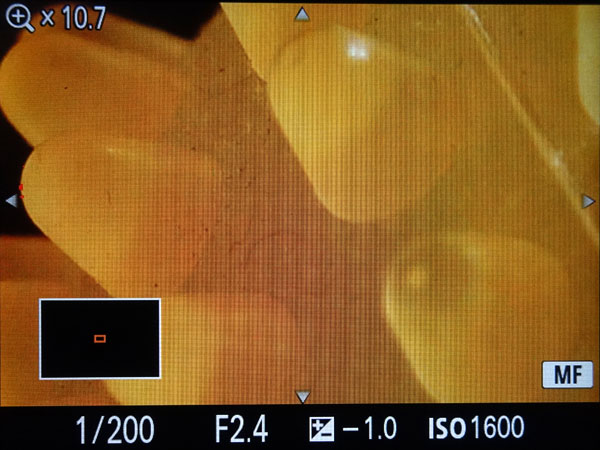 |
Figures: Manual Focus Assist combined with Focus Peaking (Peaking Color red, not visible...) (from left to right: after first button press = 5.3 x, after second button press = 10.7 x)
Moreover, the four direction buttons of the control wheel (and turning the wheel) allow you to change the position of the enlarged section within the image. Pressing the C3 button resets the section's position (not available for the RX100 M1).
When MF Assist is On, an MF appears on the screen as well as an indicator of the magnification. It would, however, be much better, if MF would be displayed all the time when the AF/MF Control Toggle is set to MF (this is only the case if you set the Display Mode to Display All Info or For Viewfinder)...
MF Assist is activated in the menu: Custom 1. p > MF Assist (On, Off). Focus Magnif. Time is set in the same menu (2 Sec, 5 Sec, No Limit). See page Configuration for details. I set the focus magnification time to No Limit.
Focus Magnifier
The Focus Magnifier function magnifies the center section of the image full screen after you press a dedicated control button (which one, can be set in the menu see page Configuration for details), starting at a magnification of 1 x. If you press the center button, magnification increases to 8.6 x, pressing again increases it to 17.1 x, pressing it once more leaves the Focus Magnifier function and returns to 1 x (see Figures below). Note that this is different from the RX100 M1, which cycles through all the three magnifications. You can also cancel magnification by half-pressing the shutter button (or if you take a photo...).
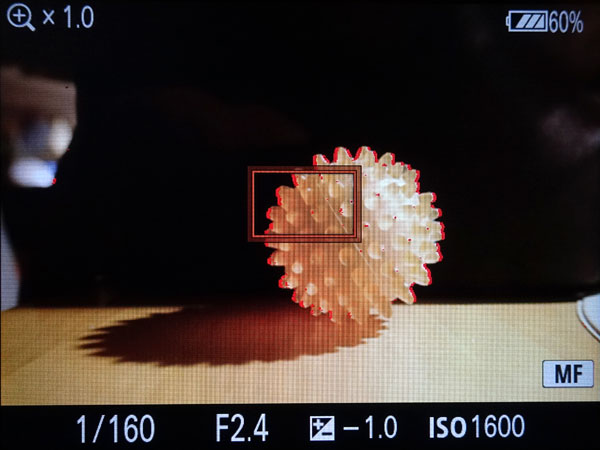 |
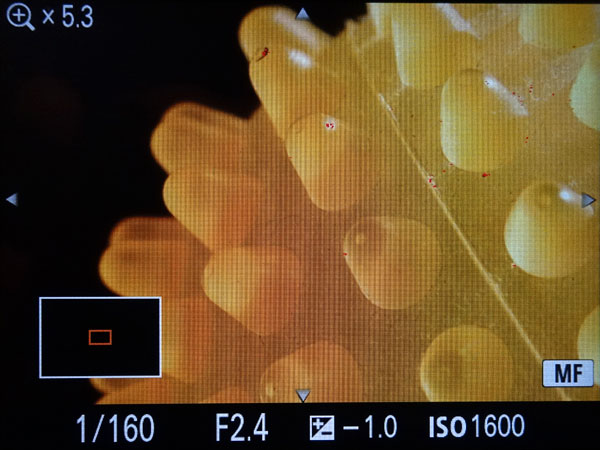 |
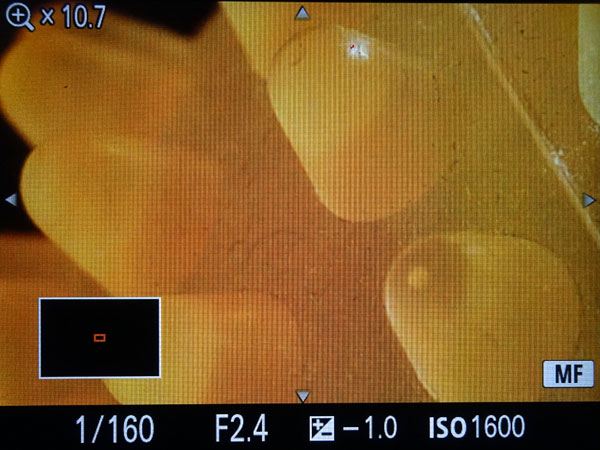 |
Figures: Focus Magnifier combined with Focus Peaking (Peaking Color red) (from left to right: after first button press = 1.0 x, after second button press = 5.3 x, after third button press = 10.7 x; another button press would leave the Focus Magnifier mode)
Moreover, the four direction buttons of the control wheel (and turning the wheel) allow you to change the position of the enlarged section within the image. Pressing the C3 button resets the section's position (not available for the RX100 M1).
When Focus Magnifier is On, an MF appears on the screen as well as an indicator of the magnification. It would, however, be much better, if MF would be displayed all the time when the AF/MF Control Toggle is set to MF (this is only the case if you set the Display Mode to Display All Info. or For Viewfinder)...
The Focus Magnifier function can be assigned to a control wheel button such as the center, left, or right button and also to the C button (which I did). See page Configuration for details.
Manual Focus Assist and Focus Magnifier
You can activate both, Manual Focus Assist and Focus Magnifier, at the same time. So you can choose whether you want to have magnification activated by both methods or only by one or even none of them.
Conclusions
For "normal" photos, I use manual focus on the Sony RX100 M1 only on rare occasions. My personal problem with manual focusing is that, being used to an EVF, I find it hard to recognize on the LCD screen when an object is in focus - even focus peaking and magnification do not help me much, particularly if it is too bright. The EVF of the RX100 M4 and on the RX10 M3/4 seems to make things better, particularly the larger image in the EVF of the RX10 M3/4. There is still the sluggish behavior of the focus ring, though...
One instance for using manual focus are photos of the sky. Here, autofocus often cannot find a target, and therefore I set/lock the focus to/on infinity using the distance scale, which is much easier than on the M1, where you have to manually focus a distant target (or turn the control ring until you believe infinity has been reached...). I also use the "infinity" trick for situations when objects in the foreground might fool the autofocus (a fence, flowers, branches, people...).
Note, however, that the "infinity trick" works only if there is something to focus on. If you want to make photos of the blue or dard sky (perhaps with a few stars...) there is no object to focus on. Turning MF on and setting the distance to infinity using the "infinity marker" on the distance scale does not work; instead, this procedure delivers fuzzy results. In the end, this seems to be "known behavior" of the camera (see the discussion in the appendix, and there is no real work around for this...).
Another instance are sports photos where autofocus is often far too slow. Here, focus lock can be an alternative to AF as well: Either you pre-focus, keep the shutter button half-pressed, and wait for "the" moment. Or you set the distance using AF and a suitable target at the expected distance, lock focus by switching from AF to MF, and then wait for "the" moment.
My main application for manual focus are close-up photos, because here it often happens that autofocus does not lock or finds the wrong target. Even the Center autofocus area, providing a "large spot" AF, is not of much help here. I tried the Flexible Spot autofocus area, which offers "spot AF" in three sizes (two small than the Center area) and after a few first uses got the impression that this would improve matters (see page Focusing with the Flexible Spot for details). But I have not yet really tested this...
See page Close-Up Introduction and First Samples for details on taking close-up photos with the Sony RX10 M3.
Note: For a more general overview of manual focusing methods, see page Manual Focusing Methods.
References
- Alexander S. White (2016). Photographer’s Guide to the Sony DSC-RX10 III. White Knight Press, Henrico, Virginia (ISBN: 978-1-937986-54-4 (paperback), 978-1-937986-55-1 (ebook))
- Henning Fuchs (2016). Sony RX10 III - Die fehlende Anleitung. Amazon CreateSpace Independent Publishing (ISBN: 978-1537703459 (paperback)).
- Sony RX10 III: The Swiss Army Knife of Cameras (Craig Litten on Steve Huff's Site): www.stevehuffphoto.com/2016/08/05/sony-rx10-iii-the-swiss-army-knife-of-cameras-by-craig-litten
- Michael Nagel (2018). Sony RX10 IV. Franzis Verlag: Haar bei München (ISBN: 978-3-645-60603-5)
Appendix: Discussion of Setting the Focus to Infinity
The following section was talken from the "Comments" section of the article Sony RX10 III: The Swiss Army Knife of Cameras by Craig Litten:
David Stahl says:
AUGUST 7, 2016 AT 3:28 PMI”ve been trying a little astrophotography but have been unsuccessful
at setting the focus to infinity on the RX10III; the focus assist claims to
have set it but, alas, infinity isn’t infinity on this camera. Am I missing
something?
CGL says:
AUGUST 8, 2016 AT 12:47 PM
As much as I’d like to help David, astrophotography is something I
haven’t tried. As for focusing to infinity, your findings could be
true. Have you tried the DP Review forums? Sorry I couldn’t help.
John says:
AUGUST 16, 2016 AT 5:20 PM
You can’t set any camera to infinity focus to do astrophotography.
You have to use manual focus mode to manually focus the lens. I plan to use
my rx10 iii to video the total solar eclipse in 2017, which will require
manual focusing and manual exposure control.
David Stahl says:
AUGUST 17, 2016 AT 10:12 AM
I have tried manually focusing on infinity but w/o success; I set the
switch on the front of the camera to MF and then used the on screen guide
to move the indicator toward infinity as I slowly rotate the front focus
ring, but,
alas every photo of the night sky is out of focus. I tried variations
incl. just before infinity, right on and ‘past’ infinity — all
give the same out-of-focus result. It’s as if I missing a setting– but
what?
John says:
AUGUST 18, 2016 AT 1:08 AM
You must focus on the subject, not some elusive “infinity” marker,
which, even if you get on it, won’t guarantee your subject is in focus!
David Stahl says:
AUGUST 18, 2016 AT 11:51 PM
Well, if the subject is a constellation or the Milky Way, you have no
way to focus on the subject as you’ll see no light in your viewfinder/LCD
screen. The only way I know how to fool the camera in this situation is to
(a) turn on autofocus, (b) have the camera focus on a light source about
50+ yards away, (c) change back to manual focus, and (d) take the picture.
That’s a “tried and true” method that’s been around
for sometime to achieve infinity focus absent a lens marking. By the by,
when shooting stars with a Sony a6300 with a lens absent an infinity mark,
the similar display provided does work when you use manual focus — i.e.,
infinity is infinity on that Sony camera. So did no one test the RX10III?!
Why provide a non-functional infinity mark?
DEREK ADAMS says:
AUGUST 18, 2016 AT 10:22 AM
I’m no expert but surely if you focus on the moon, everything else
up there will be in focus. But then again I might be completely wrong.
David Stahl says:
AUGUST 18, 2016 AT 11:17 PM
Your are correct, however, most astrophotograhers who shoot the stars
and the Milky Way prefer darker skies absent any moonlight.
| 09.02.2021 |
